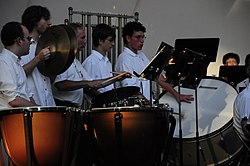This article needs additional citations for verification .(April 2021) |

The percussion section is one of the main divisions of the orchestra and the concert band. It includes most percussion instruments and all unpitched instruments.
Contents
The percussion section is itself divided into three subsections:
- Pitched percussion, consisting of pitched instruments such as glockenspiel and tubular bells.
- Auxiliary percussion, consisting of all unpitched instruments such as snare drum and cymbals.
- Timpani.
These three subsections reflect the three main skill areas that a percussionist studies.
Percussion sections, consisting of similar instruments, may also be found in stage bands and other musical ensembles. [1]

